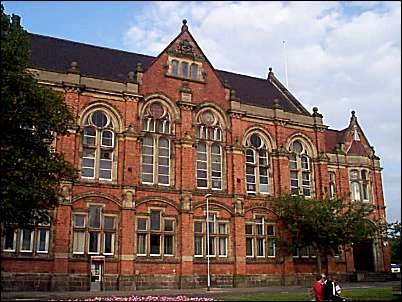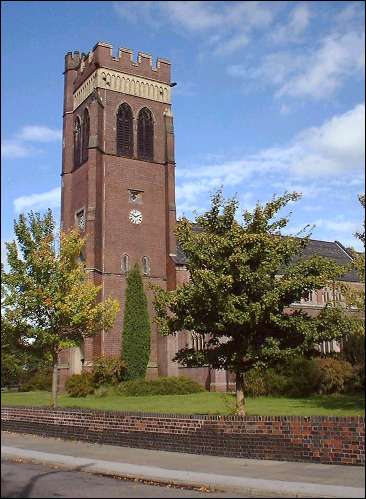|
Lower Lane
- 'Majestic church symbol of towering aspirations'
  
click the "contents"
button to get back to the main index & map
next: Winton Fields
previous:
Lane Delph
|
Historian Fred Hughes writes....
"Councillor Stan Bate once proved to me by geometric analysis that
Albert Square is the topographic centre of Stoke-on-Trent. He'd worked out
that Fenton Manor swimming pool is exactly six-and-a-quarter miles from
the extremities of the north of the city, and five-and-three-quarters from
the southern boundaries.
"So," reasoned Stan, "simple adjustment means that Albert Square has
got to be the city's physical midpoint."
|

Fenton Town Hall in Albert Square
Albert Square is the planner's blueprint of the perfect urban layout.
And if it really is the Potteries' centre it is down to one family.
"The Bakers are the family that single-handedly
built Fenton," claims historian Steve Birks. "Every building of note in
the Lower Lane area was built or influenced by the Baker family through
the acquisition of land."
William Baker was an Audlem architect who bought
Fenton estate in 1765 as a gift for his second son, also William Baker.
The son married into the Bagnall family whose head, Thomas Bagnall, was
Lord Of The Manor of Hanley. "Typically first sons were given their
father's name and so in 1771 the third William arrived on the scene,"
continues Steve.
"Matrimony yielded connections with Fenton
manufacturers, the Bournes, and soon they traded together as Bourne And
Baker. Their imposing pottery once stood on the north side of the turnpike
from Longton to Stoke, a road that used to be High Street and is now City
Road."
Fenton House was built as the family home and
stood on the high ground at the corner of Glebedale Road and City Road,
where Fenton health centre is today
"Ralph Bourne and his stepson William Baker III
extended the township by building houses on the south side of High
Street," says Steve. "By the late 1820s they had built more than 100
houses as well as the Roebuck Inn." |
Writer Alan Myatt is convinced that Fenton was a central
element to the creation of Stoke-on-Trent.
"Thomas Whieldon's estate played an important part in developing
Fenton," he says. "The first railway station in the district was built
at Fenton in 1848. Manor Street station opened in June 1864 and closed
in 1956."
Incredible though it seems, the Bournes
and Bakers had decided that Fenton should become more important than the
other five towns.
"In fact," says Steve Birks, "When Ralph Bourne
died in 1835 he willed a generous £3,000 to build an Anglican church,
topped-up by Baker's widow. The original church was demolished and
replaced by the extraordinary Christ Church designed by Charles Lynam,
from funds raised by the Baker family, and built in 1890 to seat almost
2,000."
Lynam was the city's most influential architect
in his time.
"Many public buildings are among his work," says
Steve. "Stoke's Free Library, baths and market complex, the Hartshill
cemetery chapels, and part of The North Staffordshire Infirmary at
Hartshill are examples of his designs. But according to the architectural
scholar Pevsner, Lynam's magnum opus was Fenton's Christ Church. It seemed
to impress everybody by its majestic size."

The current Christchurch
photo: c.2000 (Peter Bennett)
|
There was a time when every seat in
this simulated cathedral was occupied twice each Sunday. "I'm afraid
those days have gone," says the Reverend David Cameron, vicar for the past
12 years.
"Christ Church is certainly the centrepiece of Fenton. It reflects the
power of those benefactors who built communities around iconic buildings.
The Bakers were certainly benevolent despots. By that I mean there was a
great deal of poverty in the district then, and the church was built to
demonstrate power held by those with a position in the civic hierarchy.
These days, 40 regular worshippers is a good attendance."
There's no doubt Lynam was at his best when he built Christ Church,
with its Norman-arched skeleton stone frame, and its nave and huge
turreted tower. Inside, the ostentatious grandeur takes your breath away.
It is amply embellished with stone-framed windows, carved arches with
decorative capitals and gargoyles. An altar window depicting Christ's life
is emphasised by a superb chancel screen. Two side chapels complement this
arena, bedded on a floor of Minton tiles and rosewood blocks. Why, in a
domain like this is church-going waning?
"We work hard at being a part of Fenton's community," says David.
"Every day we ring the bells to let people know we are praying for them." |
Meanwhile a young man darts in to sit in private prayer. A few minutes
pass until he is interrupted by a woman. "Come on Chris," she urges,
"They've called your name."
A reminder that another outstanding Baker building sits next door in
the contours of the Gothic town hall, used these days as the city's
central magistrates court.
 on Lower Lane
on Lower Lane
next week: Stoke town
  
click the "contents"
button to get back to the main index & map
next: Winton Fields
previous:
Lane Delph
|